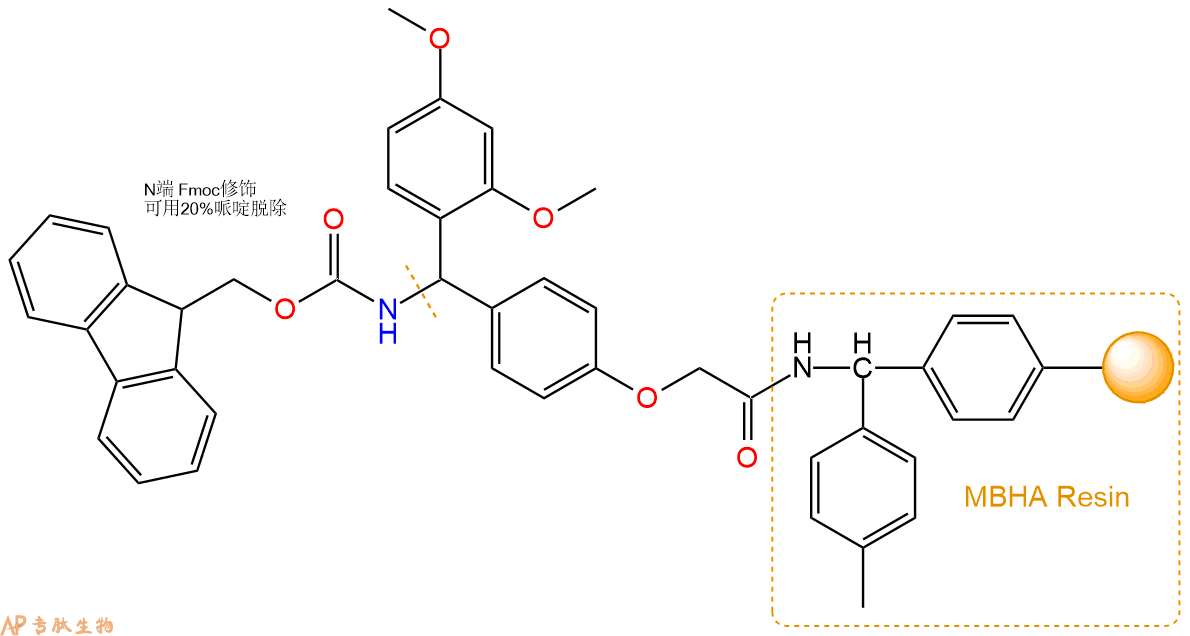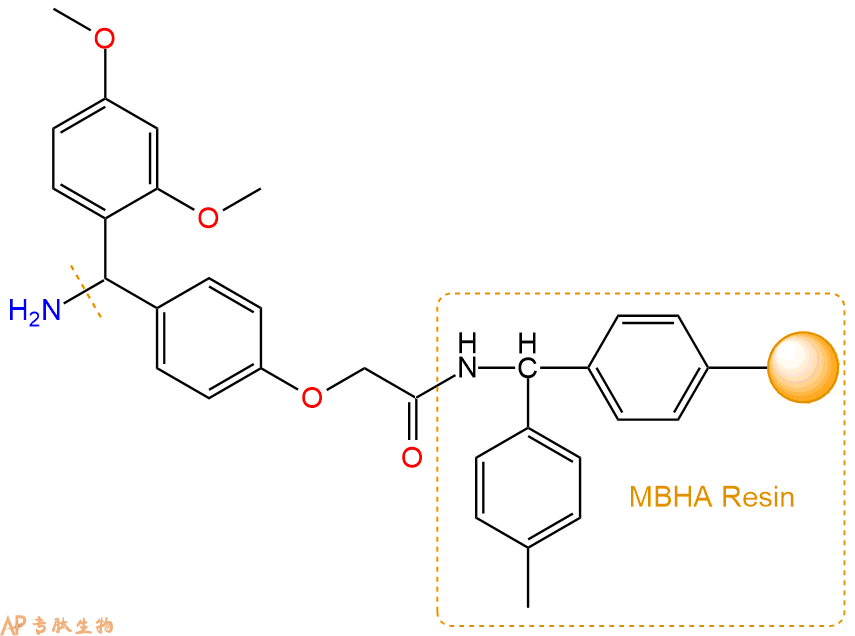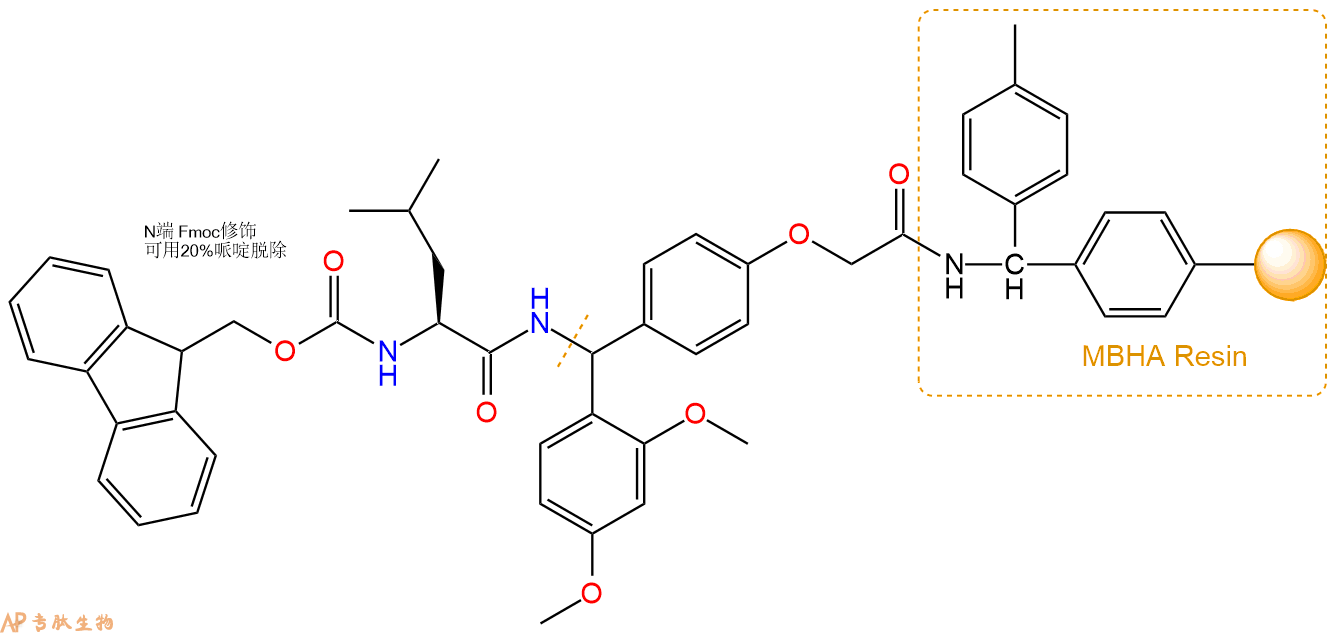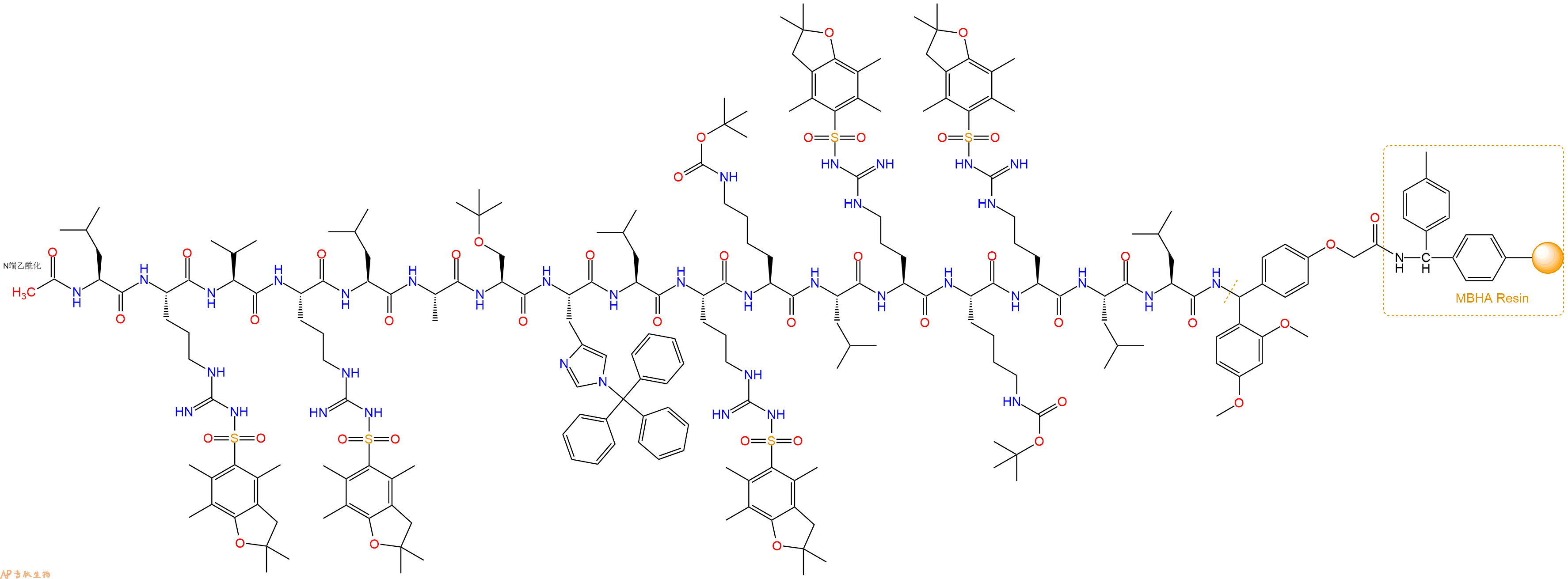
载脂蛋白 E (Apolipoprotein E, APOE) 肽的片段,与 ApoE 全息蛋白竞争结合 LDL 受体,具有有效的抗炎和神经保护作用。
编号:200724
CAS号:514200-66-9/2763583-75-9/2828432-37-5
单字母:Ac-LRVRLASHLRKLRKRLL-NH2
| 编号: | 200724 |
| 中文名称: | 载脂蛋白E(ApoE)模拟肽 COG 133 |
| 英文名: | COG 133 |
| CAS号: | 514200-66-9,free base 2763583-75-9,醋酸盐 2828432-37-5,TFA盐 |
| 单字母: | Ac-LRVRLASHLRKLRKRLL-NH2 |
| 三字母: | Ac N端乙酰化封端 -Leu亮氨酸 -Arg精氨酸 -Val缬氨酸 -Arg精氨酸 -Leu亮氨酸 -Ala丙氨酸 -Ser丝氨酸 -His组氨酸 -Leu亮氨酸 -Arg精氨酸 -Lys赖氨酸 -Leu亮氨酸 -Arg精氨酸 -Lys赖氨酸 -Arg精氨酸 -Leu亮氨酸 -Leu亮氨酸 -NH2C端酰胺化 |
| 氨基酸个数: | 17 |
| 分子式: | C97H181O19N37 |
| 平均分子量: | 2169.71 |
| 精确分子量: | 2168.43 |
| 等电点(PI): | - |
| pH=7.0时的净电荷数: | 7.24 |
| 平均亲水性: | 0.47058823529412 |
| 疏水性值: | -0.32 |
| 消光系数: | - |
| 来源: | 人工化学合成,仅限科学研究使用,不得用于人体。 |
| 储存条件: | 负80℃至负20℃ |
| 标签: | 抗炎肽(Anti-Inflammatory Peptide) 炎症研究 拮抗剂相关肽(Antagonist Peptide) |
COG 133 TFA 是载脂蛋白 E (Apolipoprotein E, APOE) 肽的片段。COG 133 与 ApoE 全息蛋白竞争结合 LDL 受体,具有有效的抗炎和神经保护作用。COG 133 TFA 也是 nAChR 拮抗剂,IC50 为 445 nM。
COG 133 TFA is a fragment of Apolipoprotein E (APOE) peptide. COG 133 TFA competes with the ApoE holoprotein for binding the LDL receptor, with potent anti-inflammatory and neuroprotective effects. COG 133 TFA is also a nAChR antagonist with an IC50 of 445 nM[1][2].
COG133是载脂蛋白E(APOE)肽的片段,具有强大的抗炎和神经保护作用。COG 133也是nAChR拮抗剂,其IC50为445nM。COG133(0.02、0.2和2.0μM)改善了无谷氨酰胺培养基中的细胞数量。在IEC-6细胞中,COG133(0.2-20μM)改善了5-FU激发后的细胞迁移,达到了与对照组相同的迁移水平。COG133(3μM)显著增加C57BL6J野生型动物的有丝分裂隐窝数量。COG133治疗改善了隐窝结构并减少了固有层炎症。COG133(3μM)可显著降低肠道MPO水平。COG133部分降低5-FU处理小鼠近端小肠的TNF-α水平。在野生型和ApoE敲除小鼠中,COG 133(3μM)逆转了5-FU诱导的近端肠中Tunel阳性细胞的增加。COG133在改善的肠粘膜中引起NF-κB的高表达。
COG 133 is a fragment of Apolipoprotein E (APOE) peptide with potent anti-inflammatory and neuroprotective effects. COG 133 is also a nAChR antagonist with an IC50 of 445 nM. COG 133 (0.02, 0.2, and 2.0 μM) improved cell numbers in glutamine free media. In IEC-6 cells, COG 133 (0.2-20 μM) improved cell migration following 5-FU challenge, reaching the same migration level as controls. COG 133 (3 μM) significantly increased the mitotic crypt numbers in C57BL6J wild-type animals. COG 133 treatment improved crypt architecture and reduced lamina propria inflammation. COG 133 (3 μM) significantly reduced the intestinal MPO levels. COG 133 partially decreased TNF-α level in the proximal small intestine from 5-FU-treated mice. In both wild-type and ApoE knock-out mice, COG 133 (3 μM) reverted the increase in Tunel-positive cells in the proximal intestine induced by 5-FU. COG 133 caused higher expression of the NF-κB in the improved intestinal mucosa.
COG 133的化学式为C97H181N37O19,氨基酸序列为Ac-Leu-Arg-Val-Arg-Leu-Ala-Ser-His-Leu-Arg-Lys-Leu-Arg-Lys-Arg-Leu-Leu-amide,分子量为2169.73。载脂蛋白E(ApoE)含有299个氨基酸,它参与运输脂蛋白、脂溶性维生素和胆固醇进入淋巴系统,然后进入血液。它主要在肝脏中合成,但在其它组织如脑、肾和脾也有发现。载脂蛋白E主要产生于神经系统、非神经元细胞以及星形胶质细胞和小胶质细胞,神经元优先表达APOE的受体。目前鉴定得到了哺乳动物的七种APOE受体,APOE受体属于低密度脂蛋白受体家族,进化上相对保守。最初发现APOE是因其在脂蛋白代谢和心血管疾病中的重要性。APOE缺陷导致家族性血β脂蛋白异常,又称Ⅲ型高脂蛋白血症(HLP III),其中乳糜微粒、极低密度脂蛋白和低密度脂蛋白的残余物清除受损,造成血浆胆固醇和甘油三酯增加。最近研究了其在与脂蛋白运输没有直接关系的生物学过程中的作用,包括阿尔兹海默症(AD)、免疫调节和认知。
COG 133 acetate is a fragment of ApoE that exhibits anti-inflammatory and neuroprotective effects and could also be an antagonist at α7 nicotinic acetylcholine receptors.
COG 133醋酸盐是ApoE的一个片段,具有抗炎和神经保护作用,也可能是α7烟碱型乙酰胆碱受体的拮抗剂。
COG133 is a peptide fragment of ApoE that corresponds to residues 133-149 of the ApoE LDL receptor-binding domain and an antagonist of α7 nicotinic acetylcholine receptors (nAChRs; IC50 = 720 nM). It suppresses TNF-α and nitric oxide (NO) release in BV-2 microglia when used at concentrations ranging from 10 to 50 µM.
COG133是ApoE的肽片段,其对应于ApoE LDL受体结合结构域的残基133-149,并且是α7烟碱型乙酰胆碱受体(nAChRs;IC50=720nM)的拮抗剂。当浓度为10至50µM时,它可以抑制BV-2小胶质细胞中TNF-α和一氧化氮(NO)的释放。
Definition
Small, anti-inflammatory peptides are useful to inhibit inflammation of a mammal's skin, mucous membranes, or lacerations of the musculature or injury to the brain or leakage of fluids into the air spaces of the lungs.
Discovery
Camussi G in 1986 described platelet-activating factor (PAF) as a phospholipid (1-0-alkyl-2-sn-acetyl-glycero-3-phosphocholine) mediator of inflammation and endotoxic shock. Polymorphonuclear neutrophils (PMN), peritoneal macrophages, vascular endothelial cells, basophils, and platelets synthesize PAF rapidly after appropriate stimuli 1. For example, TNF or phagocytosis promotes synthesis and release of PAF in PMN or macrophages within 10 min 2. These stimuli induce phospholipase A2 (PLA2) activity that cleaves membrane phospholipids into lyso-PAF and arachidonic acid. Thrombin stimulates PAFsynthesis in endothelial cells also within 10 min 3. Other proteinases, such as elastase, stimulate PAF synthesis rapidly in PMN, macrophages, and endothelial cells, and induce PLA2 and acetyltransferase activity. Conversely, different proteinase inhibitors block PAF synthesis induced by TNF. These findings led to the hypothesis that proteinases added to cells and cellular proteinases activated by TNF cleave proteins inhibitory for PLA2, such as lipocortins 4. Lipocortins belong to a family of related proteins that mediate the anti-inflammatory activity of corticosteroids.
Structural Characteristics
Cloning and sequencing of lipocortins cDNA has provided the amino acid sequence of anti-inflammatory proteins. Steroid induced protein with PLA2 inhibitory activity is uteroglobin, a rabbit secretory protein 5. Two identical subunits of 70 amino acids form uteroglobin; lipocortin I and II comprise four nonidentical repeats of 70 amino acids. Miele et al., have noticed a striking sequence similarity between amino acid residues 40-46 of uteroglobin and 247-253 of lipocortin I, repeat 3. Synthetic peptides designated "antiflammins" that correspond to such sequences show potent PLA2 inhibitory activity in vitro and an antiinflammatory effect on carrageenan induced rat foot pad edema in vivo 6, 7. SV-IV is a basic, thermostable, secretory protein of low Mr (9758) that is synthesized by rat seminal vesicle (SV) epithelium under strict androgen transcriptional control. By using two different experimental, data were obtained showing that in this protein: (a) the immunomodulatory activity is related to the structural integrity of the whole molecule; (b) the anti-inflammatory activity is located in the N-terminal region of the molecule, the 8-16 peptide fragment being the most active; (c) the identified anti-inflammatory peptide derivatives do not seem to possess pro-coagulant activity, even though this particular function has been located in the 1-70 segment of the molecule 8. The peptide HDMNKVLDL (antiflammin-2) inhibits the synthesis of PAF induced by TNF or phagocytosis in rat macrophages and human neutrophils, and by thrombin in vascular endothelial cells. The peptide MQMKKVLDS (antiflammin-1) is less inhibitory than antiflammin-2 for macrophages and not inhibitory for neutrophils after a 5-min preincubation 9.
Mode of Action
PLA2 are a family of esterases that initiate the arachidonic acid cascade, resulting in the production of numerous inflammatory mediators. Lipocortins are inhibitors of PLA2. Peptides corresponding to a region of high amino-acid sequence similarity between uteroglobin and lipocortin I have potent PLA2 inhibitory activity. Several synthetic peptides corresponding to the region of highest similarity were designed by Miele, L. et al., The most effective anti-inflammatory nonapeptides, termed antiflammins (AFs) correspond to uteroglobin residues 39–47 and lipocortin-1 residues 246–254. Both peptides are PLA2 inhibitors in-vitro and are effective in a classic model of acute inflammation in carrageenan-induced rat footpad edema. The nonapeptides have anti-inflammatory effects in-vitro and in-vivo 10. Antiflammin-1 is inactivated by neutrophils secretory products, possibly oxidizing agents. Synthesis of PAF is inhibited by antiflammin-2 without an appreciable lag, but this inhibition is reversed when neutrophils or macrophages are washed and incubated in fresh medium. Antiflammins must be continuously present to inhibit PAF synthesis. Antiflammins block activation of the acetyltransferase required for PAF synthesis, suggesting that this enzyme is another target for the inhibitory activity of antiflammins. These peptides inhibit neutrophil aggregation and chemotaxis induced by complement component C5a 9.
Functions
Bee venom, in a study of phospholipase-A2,3 nearly 1 kg of freeze-dried bee venom was fractionated and tested all the fractions for anti-inflammatory activity. Experiments showed activity to be associated with the basic peptide fraction 11.
PAF synthesis, anti-inflammatory peptides inhibit PAF synthesis in PMN, macrophages, and endothelial cells stimulated by TNF, phagocytosis, or proteinases 9.
PMN aggregation and chemotaxis, the antiflammins inhibit also PMN aggregation and chemotaxis, and suppress the inflammatory reaction induced in rat skin by in situ formation of immune complexes or by intradermal injection of TNF and complement component C5a 9.
References
1. Camussi G (1986). Potential role of platelet-activating factor in renal pathophysiology. Kidney Int., 29: 469-477.
2. Camussi G, Bussolino F, Salvidio G, Baglioni C (1987). Tumor necrosis factor/cachectin stimulates rat peritoneal macrophages and human endothelial cells to synthesize and release platelet activating factor. J. Exp. Med., 166:1390-1404.
3. Prescott SM (1984). Human endothelial cells in culture produce platelet-activating factor (1-alkyl-2-acetyl-sn-glyceryl-3-phosphocholine) when stimulated with thrombin. PNAS., 81:3534-3538.
4. Camussi G, Tetta C, Bussolino F, Baglioni C (1988). Synthesis and release of platelet-activating factor is inhibited by plasma a,proteinase inhibitor or citantichymotrypsin and stimulated by proteinases . J. Exp. Med., 168:1293-1306.
5. Levin SW, Butler JD, Schumacher UK, Wightman PD, Mukherjee AB (1986). Uteroglobin inhibits phospholipase A2 activity. Life Sci., 38:1813-1819.
6. Morize I, Surcouf E, Vaney MC, Epelboin Y, Buehner M, Fridlansky F, Milgrom E, Mornon JP (1987) . Refinement of the C222 crystal formofoxidized uteroglobin at 1 .34 A resolution. J. Mol. Biol., 194:725-739.
7. Miele L, Cordella-Miele E, Facchiano A, Mukherjee AB (1988). Novel anti-inflammatory peptides from the region of highest similarity between uteroglobin and lipocortin I. Nature, 335:726-730.
8. Ialenti A, Santagada V, Caliendo G, Severino B, Fiorino F, Maffia P, Ianaro A, Morelli F, Di Micco B, Cartenì M, Stiuso P, Metafora V, Metafora S (2001). Synthesis of novel anti-inflammatory peptides derived from the amino-acid sequence of the bioactive protein SV-IV. FEBS Journal, 268(12):3399-3406.
9. Camussi G, Tetta C, Bussolino F, Baglioni C (1990). Antiinflamatory peptides (antiinflamins) inhibit synthesis of platelet-activating factor, neutrophil aggregation and chemotaxis, and interdermal inflammatory reactions. J. Exp. Med., 171:913-927.
10. Sohn J, Kim TI, Yoon YH, Kim JY, Kim SY (2003). Novel transglutaminase inhibitors reverse the inflammation of allergic conjunctivitis. J. Clin. Invest., 111(1):121-128.
11. Billingham ME, Morley J, Hanson JM, Shipolini RA, Vernon CA (1973). Letter: An anti-inflammatory peptide from bee venom. Nature, 245(5421):163-164.
| DOI | 名称 | |
|---|---|---|
| 10.1186/1471-230X-12-35 | Apolipoprotein E COG 133 mimetic peptide improves 5-fluorouracil-induced intestinal mucositis | 下载 |
| 10.1124/jpet.105.095505 | Apolipoprotein E-derived peptides block alpha7 neuronal nicotinic acetylcholine receptors expressed in xenopus oocytes | 下载 |
| 10.1172/jci.insight.134539 | Monocyte-derived alveolar macrophage apolipoprotein E participates in pulmonary fibrosis resolution | 下载 |
多肽Ac-Leu-Arg-Val-Arg-Leu-Ala-Ser-His-Leu-Arg-Lys-Leu-Arg-Lys-Arg-Leu-Leu-NH2的合成步骤:
1、合成MBHA树脂:取若干克MBHA树脂(如初始取代度为0.5mmol/g)和1倍树脂摩尔量的Fmoc-Linker-OH加入到反应器中,加入DMF,搅拌使氨基酸完全溶解。再加入树脂2倍量的DIEPA,搅拌混合均匀。再加入树脂0.95倍量的HBTU,搅拌混合均匀。反应3-4小时后,用DMF洗涤3次。用2倍树脂体积的10%乙酸酐/DMF 进行封端30分钟。然后再用DMF洗涤3次,甲醇洗涤2次,DCM洗涤2次,再用甲醇洗涤2次。真空干燥12小时以上,得到干燥的树脂{Fmoc-Linker-MHBA Resin},测定取代度。这里测得取代度为 0.3mmol/g。结构如下图:

2、脱Fmoc:取2.62g的上述树脂,用DCM或DMF溶胀20分钟。用DMF洗涤2遍。加3倍树脂体积的20%Pip/DMF溶液,鼓氮气30分钟,然后2倍树脂体积的DMF 洗涤5次。得到 H2N-Linker-MBHA Resin 。(此步骤脱除Fmoc基团,茚三酮检测为蓝色,Pip为哌啶)。结构图如下:

3、缩合:取2.36mmol Fmoc-Leu-OH 氨基酸,加入到上述树脂里,加适当DMF溶解氨基酸,再依次加入4.72mmol DIPEA,2.24mmol HBTU。反应30分钟后,取小样洗涤,茚三酮检测为无色。用2倍树脂体积的DMF 洗涤3次树脂。(洗涤树脂,去掉残留溶剂,为下一步反应做准备)。得到Fmoc-Leu-Linker-MBHA Resin。氨基酸:DIPEA:HBTU:树脂=3:6:2.85:1(摩尔比)。结构图如下:

4、依次循环步骤二、步骤三,依次得到
H2N-Leu-Linker-MBHA Resin
Fmoc-Leu-Leu-Linker-MBHA Resin
H2N-Leu-Leu-Linker-MBHA Resin
Fmoc-Arg(Pbf)-Leu-Leu-Linker-MBHA Resin
H2N-Arg(Pbf)-Leu-Leu-Linker-MBHA Resin
Fmoc-Lys(Boc)-Arg(Pbf)-Leu-Leu-Linker-MBHA Resin
H2N-Lys(Boc)-Arg(Pbf)-Leu-Leu-Linker-MBHA Resin
Fmoc-Arg(Pbf)-Lys(Boc)-Arg(Pbf)-Leu-Leu-Linker-MBHA Resin
H2N-Arg(Pbf)-Lys(Boc)-Arg(Pbf)-Leu-Leu-Linker-MBHA Resin
Fmoc-Leu-Arg(Pbf)-Lys(Boc)-Arg(Pbf)-Leu-Leu-Linker-MBHA Resin
H2N-Leu-Arg(Pbf)-Lys(Boc)-Arg(Pbf)-Leu-Leu-Linker-MBHA Resin
Fmoc-Lys(Boc)-Leu-Arg(Pbf)-Lys(Boc)-Arg(Pbf)-Leu-Leu-Linker-MBHA Resin
H2N-Lys(Boc)-Leu-Arg(Pbf)-Lys(Boc)-Arg(Pbf)-Leu-Leu-Linker-MBHA Resin
Fmoc-Arg(Pbf)-Lys(Boc)-Leu-Arg(Pbf)-Lys(Boc)-Arg(Pbf)-Leu-Leu-Linker-MBHA Resin
H2N-Arg(Pbf)-Lys(Boc)-Leu-Arg(Pbf)-Lys(Boc)-Arg(Pbf)-Leu-Leu-Linker-MBHA Resin
Fmoc-Leu-Arg(Pbf)-Lys(Boc)-Leu-Arg(Pbf)-Lys(Boc)-Arg(Pbf)-Leu-Leu-Linker-MBHA Resin
H2N-Leu-Arg(Pbf)-Lys(Boc)-Leu-Arg(Pbf)-Lys(Boc)-Arg(Pbf)-Leu-Leu-Linker-MBHA Resin
Fmoc-His(Trt)-Leu-Arg(Pbf)-Lys(Boc)-Leu-Arg(Pbf)-Lys(Boc)-Arg(Pbf)-Leu-Leu-Linker-MBHA Resin
H2N-His(Trt)-Leu-Arg(Pbf)-Lys(Boc)-Leu-Arg(Pbf)-Lys(Boc)-Arg(Pbf)-Leu-Leu-Linker-MBHA Resin
Fmoc-Ser(tBu)-His(Trt)-Leu-Arg(Pbf)-Lys(Boc)-Leu-Arg(Pbf)-Lys(Boc)-Arg(Pbf)-Leu-Leu-Linker-MBHA Resin
H2N-Ser(tBu)-His(Trt)-Leu-Arg(Pbf)-Lys(Boc)-Leu-Arg(Pbf)-Lys(Boc)-Arg(Pbf)-Leu-Leu-Linker-MBHA Resin
Fmoc-Ala-Ser(tBu)-His(Trt)-Leu-Arg(Pbf)-Lys(Boc)-Leu-Arg(Pbf)-Lys(Boc)-Arg(Pbf)-Leu-Leu-Linker-MBHA Resin
H2N-Ala-Ser(tBu)-His(Trt)-Leu-Arg(Pbf)-Lys(Boc)-Leu-Arg(Pbf)-Lys(Boc)-Arg(Pbf)-Leu-Leu-Linker-MBHA Resin
Fmoc-Leu-Ala-Ser(tBu)-His(Trt)-Leu-Arg(Pbf)-Lys(Boc)-Leu-Arg(Pbf)-Lys(Boc)-Arg(Pbf)-Leu-Leu-Linker-MBHA Resin
H2N-Leu-Ala-Ser(tBu)-His(Trt)-Leu-Arg(Pbf)-Lys(Boc)-Leu-Arg(Pbf)-Lys(Boc)-Arg(Pbf)-Leu-Leu-Linker-MBHA Resin
Fmoc-Arg(Pbf)-Leu-Ala-Ser(tBu)-His(Trt)-Leu-Arg(Pbf)-Lys(Boc)-Leu-Arg(Pbf)-Lys(Boc)-Arg(Pbf)-Leu-Leu-Linker-MBHA Resin
H2N-Arg(Pbf)-Leu-Ala-Ser(tBu)-His(Trt)-Leu-Arg(Pbf)-Lys(Boc)-Leu-Arg(Pbf)-Lys(Boc)-Arg(Pbf)-Leu-Leu-Linker-MBHA Resin
Fmoc-Val-Arg(Pbf)-Leu-Ala-Ser(tBu)-His(Trt)-Leu-Arg(Pbf)-Lys(Boc)-Leu-Arg(Pbf)-Lys(Boc)-Arg(Pbf)-Leu-Leu-Linker-MBHA Resin
H2N-Val-Arg(Pbf)-Leu-Ala-Ser(tBu)-His(Trt)-Leu-Arg(Pbf)-Lys(Boc)-Leu-Arg(Pbf)-Lys(Boc)-Arg(Pbf)-Leu-Leu-Linker-MBHA Resin
Fmoc-Arg(Pbf)-Val-Arg(Pbf)-Leu-Ala-Ser(tBu)-His(Trt)-Leu-Arg(Pbf)-Lys(Boc)-Leu-Arg(Pbf)-Lys(Boc)-Arg(Pbf)-Leu-Leu-Linker-MBHA Resin
H2N-Arg(Pbf)-Val-Arg(Pbf)-Leu-Ala-Ser(tBu)-His(Trt)-Leu-Arg(Pbf)-Lys(Boc)-Leu-Arg(Pbf)-Lys(Boc)-Arg(Pbf)-Leu-Leu-Linker-MBHA Resin
Fmoc-Leu-Arg(Pbf)-Val-Arg(Pbf)-Leu-Ala-Ser(tBu)-His(Trt)-Leu-Arg(Pbf)-Lys(Boc)-Leu-Arg(Pbf)-Lys(Boc)-Arg(Pbf)-Leu-Leu-Linker-MBHA Resin
以上中间结构,均可在专肽生物多肽计算器-多肽结构计算器中,一键画出。
最后再经过步骤二得到 H2N-Leu-Arg(Pbf)-Val-Arg(Pbf)-Leu-Ala-Ser(tBu)-His(Trt)-Leu-Arg(Pbf)-Lys(Boc)-Leu-Arg(Pbf)-Lys(Boc)-Arg(Pbf)-Leu-Leu-Linker-MBHA Resin,结构如下:

5、乙酸酐反应连接:在上述树脂中,加入适当DMF后,再加入2.36mmol乙酸酐到树脂中,再加入4.72mmol DIPEA,鼓氮气反应30分钟。用2倍树脂体积的DMF 洗涤3次树脂(洗涤树脂,去掉残留溶剂,为下一步反应做准备)。 得到Ac-Leu-Arg(Pbf)-Val-Arg(Pbf)-Leu-Ala-Ser(tBu)-His(Trt)-Leu-Arg(Pbf)-Lys(Boc)-Leu-Arg(Pbf)-Lys(Boc)-Arg(Pbf)-Leu-Leu-Linker-MBHAResin。 结构如下:
6、切割:6倍树脂体积的切割液(或每1g树脂加8ml左右的切割液),摇床摇晃 2小时,过滤掉树脂,用冰无水乙醚沉淀滤液,并用冰无水乙醚洗涤沉淀物3次,最后将沉淀物放真空干燥釜中,常温干燥24小试,得到粗品Ac-Leu-Arg-Val-Arg-Leu-Ala-Ser-His-Leu-Arg-Lys-Leu-Arg-Lys-Arg-Leu-Leu-NH2。结构图见产品结构图。
切割液选择:1)TFA:H2O=95%:5%
2)TFA:H2O:TIS=95%:2.5%:2.5%
3)三氟乙酸:茴香硫醚:1,2-乙二硫醇:苯酚:水=87.5%:5%:2.5%:2.5%:2.5%
(前两种适合没有容易氧化的氨基酸,例如Trp、Cys、Met。第三种适合几乎所有的序列。)
7、纯化冻干:使用液相色谱纯化,收集目标峰液体,进行冻干,获得蓬松的粉末状固体多肽。不过这时要取小样复测下纯度 是否目标纯度。
8、最后总结:
杭州专肽生物技术有限公司(ALLPEPTIDE https://www.allpeptide.com)主营定制多肽合成业务,提供各类长肽,短肽,环肽,提供各类修饰肽,如:荧光标记修饰(CY3、CY5、CY5.5、CY7、FAM、FITC、Rhodamine B、TAMRA等),功能基团修饰肽(叠氮、炔基、DBCO、DOTA、NOTA等),同位素标记肽(N15、C13),订书肽(Stapled Peptide),脂肪酸修饰肽(Pal、Myr、Ste),磷酸化修饰肽(P-Ser、P-Thr、P-Tyr),环肽(酰胺键环肽、一对或者多对二硫键环),生物素标记肽,PEG修饰肽,甲基化修饰肽等。
以上所有内容,为专肽生物原创内容,请勿发布到其他网站上。





